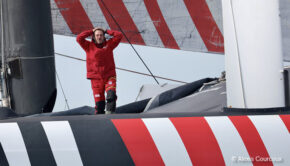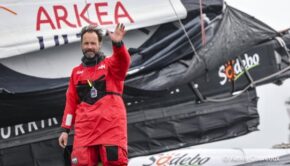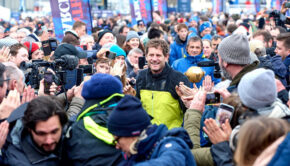Rivals together approaching Cape Horn
Published on February 8th, 2024
(February 8, 2024; Day 33) – While 2024 Arkea Ultim Challenge-Brest leader Charles Caudrelier (Maxi Edmond de Rothschild) climbs the coast of South America in the Atlantic, holding a 2300 nm advantage, the second and third placed rivals are making good speeds in the Pacific Ocean just passed Point Nemo.
Roughly 400 nm separates second placed Armel Le Cléac’h (Maxi Banque Populaire XI) from third positioned Thomas Coville (Soldebo Ultim 3). The match within the match remains engaging, a head-to-head between the two most experienced solo circumnavigators in the race as they approach Cape Horn on their Ultim Class trimarans.
Coville (55 years old) and Armel Le Cléac’h (46 years old) are well acquainted with the fearsome Cape. The skipper of Sodebo has been round the world under sail eight times (four single-handed, four crewed, six multihulls), and Le Cléac’h three times, always solo on IMOCAs in the Vendée Globe.
Le Cléac’h still holds the monohull solo round the world record at 74 days and 3 hours, and is on target to finish on the podium, just as he has every time on the Vendée Globe, 2nd in 2008, 2nd in 2012, and winning in 2016.
For the moment, they are happy in the knowledge that they have in each other a sparring partner, a benchmark skipper traveling on the same course on the same weather system doing the same speeds. There is no let up for either, both nicely positioned at the leading edge of a low pressure system.
“It’s a privilege to play this match within a match,” said Coville.
Looking back, remember that Coville started out just behind the Caudrelier-Laperche duo, in the same weather system, before foil damage dropped him out of the leading group. Behind him, Le Cléac’h became the first skipper to make a stopover, in Recife (Brazil). Then he had to fight around the Saint Helena High to get to the south. At that point, there was a gap of up to 1,500 miles between duo
Coville’s lead was eroded as he progressed through the Indian Ocean and it was Coville’s stopover in Tasmania which allowed Le Cléac’h to take the lead which he has held lead despite his northerly course around New Zealand to avoid a malicious depression.
Yesterday, they both gybed southwards to benefit from a westerly and north-westerly wind flow. In this long, otherwise lonely, passage towards the tip of South America, the advantage is still with Le Cléac’h.
Maxi Banque Populaire XI is expected to reach Cape Horn by the afternoon of February 10 with Sodebo Ultim 3 by the following morning.
As for Caudrelier, he is just over 250 nm NE of the Falkland Islands and is looking forwards to some modest downwind sailing as he starts to negotiate the high pressure to his west. As the lone entry that has not needed a pit stop, his homewards climb is not offering anything too dramatic for the meantime and patience will be his key virtue for the moment.
Details: https://arkeaultimchallengebrest.com/en
The Arkea Ultim Challenge-Brest is a solo, non-stop round-the-world race for Ultim Class trimarans which have a maximum length of 32 meters and a maximum width of 23 meters.
The solo speed record around the world was set in 2017 by François Gabart (FRA) on the 30m Macif trimaran in a time of 42d 14h 40m 15s for an average speed of 21.08 knots. This yacht has been rebranded and will be raced by Marchand.
Entrants:
• Charles Caudrelier (FRA), Maxi Edmond de Rothschild (2017 Verdier 32/23)
• Thomas Coville (FRA), Sodebo Ultim 3 (2019 VPLP/others 32/23)
• Tom Laperche (FRA), Trimaran SVR-Lazartigue (2021 VPLP 32/23)
• Armel Le Cléac’h (FRA), Maxi Banque Populaire XI (2021 VPLP 32/23)
• Anthony Marchand (FRA), Actual Ultim 3 (2015 VPLP 30/22)
• Éric Péron (FRA), Trimaran Adagio (2014 VPLP 31/21)*
* Only entrant without foiling appendages
Five rules from the Sailing Instructions:
• The start is January 7 from Brest, France. The start line is kept open for 168 hours and the finish line is closed after an elapsed time of 100 days after the start time, that is to say April 16, 2024.
• The skippers can communicate and exchange with their teams on shore, so they have the freedom to get weather information and be routed by their team on shore and get technical help and advice to help with technical problems.
• The solo skippers can stop but there are two distinct operations. A technical stop is unassisted and requires the sailor to drop anchor, take a mooring, or tie up alongside an anchored or moored boat with no external help. There is no time penalty for a technical stop. But for a technical stopover (escale technique) where one or more crew or technical team come on board to help, there is a mandatory 24 hours minimum. This does not apply to the start port of Brest where all means are authorized to reach or leave the port within a radius of 50 miles.
• For the first time in ocean racing, zones where there are known to be a high concentration of whales and sea mammals are determined. Establishing these zones should both protect the marine wildlife and reduce the chance of a collision. These zones are around the Azores, the Canaries, south of South Africa, the Kerguelens, and parts of the Antarctic.
• There are ice exclusion zones to protect the skippers and their boats.









 We’ll keep your information safe.
We’ll keep your information safe.